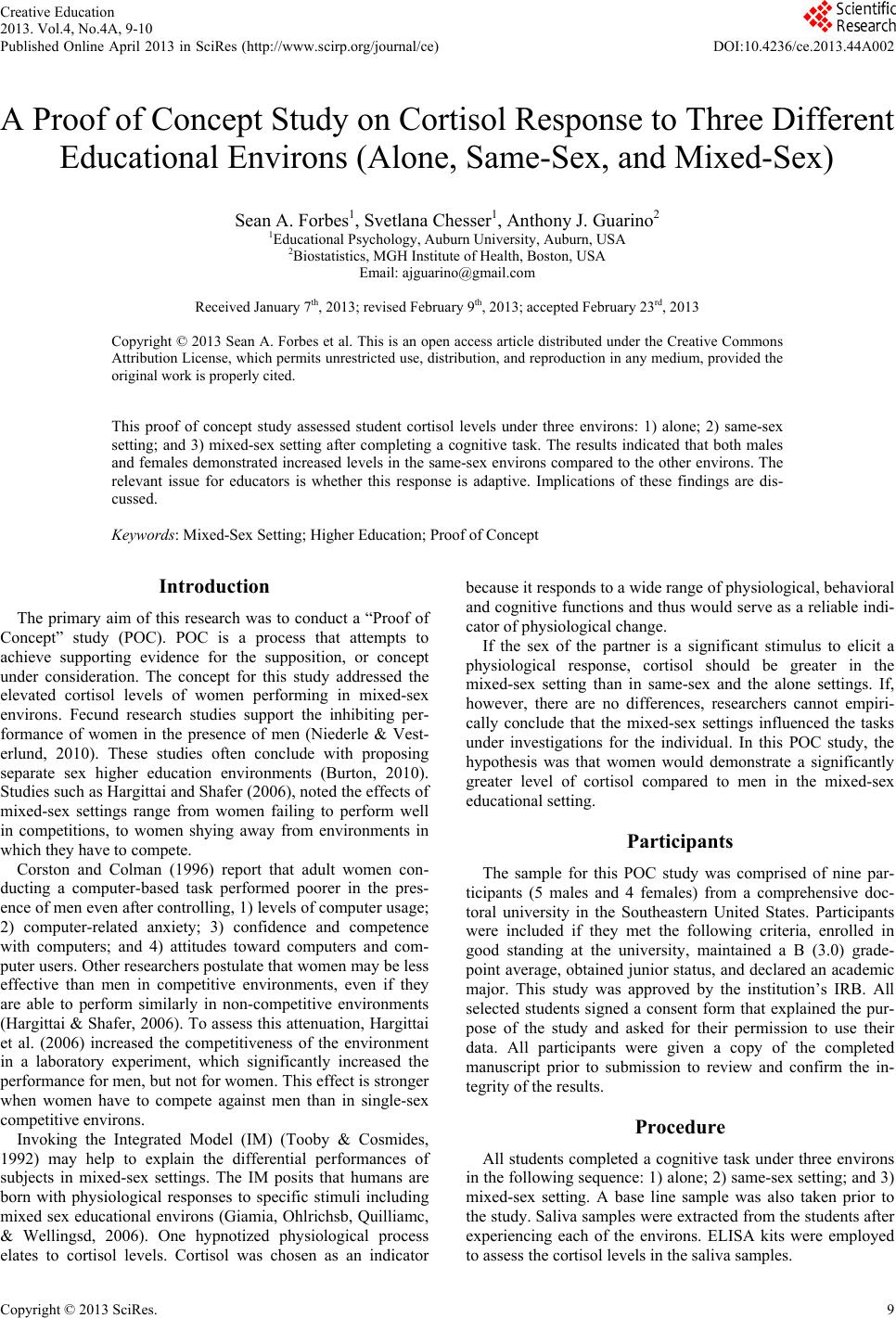
Creative Education
2013. Vol.4, No.4A, 9-10
Published Online April 2013 in SciRes (http://www.scirp.org/journal/ce) DOI:10.4236/ce.2013.44A002
A Proof of Concept Study on Cortisol Response to Three Different
Educational Environs (Alone, Same-Sex, and Mixed-Sex)
Sean A. Forbes1, Svetlana Chesser1, Anthony J. Guarino2
1Educational Psychology, A ub urn University, Auburn, USA
2Biostatistics, MGH Institute of Health, Boston, USA
Email: ajguarino@gmail.com
Received January 7th, 2013; revised February 9th, 2013; a cc ept ed F eb ru ary 23 rd, 2013
Copyright © 2013 Sean A. Forbes et al. This is an open access article distributed under the Creative Commons
Attribution License, which permits unrestricted use, distribution, and reproduction in any medium, provided the
original work is properly cited.
This proof of concept study assessed student cortisol levels under three environs: 1) alone; 2) same-sex
setting; and 3) mixed-sex setting after completing a cognitive task. The results indicated that both males
and females demonstrated increased levels in the same-sex environs compared to the other environs. The
relevant issue for educators is whether this response is adaptive. Implications of these findings are dis-
cussed.
Keywords: Mixed-Sex Setting; Higher Education; Proof of Concept
Introduction
The primary aim of this research was to conduct a “Proof of
Concept” study (POC). POC is a process that attempts to
achieve supporting evidence for the supposition, or concept
under consideration. The concept for this study addressed the
elevated cortisol levels of women performing in mixed-sex
environs. Fecund research studies support the inhibiting per-
formance of women in the presence of men (Niederle & Vest-
erlund, 2010). These studies often conclude with proposing
separate sex higher education environments (Burton, 2010).
Studies such as Hargittai and Shafer (2006), noted the effects of
mixed-sex settings range from women failing to perform well
in competitions, to women shying away from environments in
which they have to compete.
Corston and Colman (1996) report that adult women con-
ducting a computer-based task performed poorer in the pres-
ence of men even after controlling, 1) levels of computer usage;
2) computer-related anxiety; 3) confidence and competence
with computers; and 4) attitudes toward computers and com-
puter users. Other researchers postulate that women may be less
effective than men in competitive environments, even if they
are able to perform similarly in non-competitive environments
(Hargittai & Shafer, 2006). To assess this attenuation, Hargittai
et al. (2006) increased the competitiveness of the environment
in a laboratory experiment, which significantly increased the
performance for men, but not for women. This effect is stronger
when women have to compete against men than in single-sex
competitive env irons.
Invoking the Integrated Model (IM) (Tooby & Cosmides,
1992) may help to explain the differential performances of
subjects in mixed-sex settings. The IM posits that humans are
born with physiological responses to specific stimuli including
mixed sex educational environs (Giamia, Ohlrichsb, Quilliamc,
& Wellingsd, 2006). One hypnotized physiological process
elates to cortisol levels. Cortisol was chosen as an indicator
because it responds to a wide range of physiological, behavioral
and cognitive functions and thus would serve as a reliable indi-
cator of physiological change.
If the sex of the partner is a significant stimulus to elicit a
physiological response, cortisol should be greater in the
mixed-sex setting than in same-sex and the alone settings. If,
however, there are no differences, researchers cannot empiri-
cally conclude that the mixed-sex settings influenced the tasks
under investigations for the individual. In this POC study, the
hypothesis was that women would demonstrate a significantly
greater level of cortisol compared to men in the mixed-sex
educational setting.
Participants
The sample for this POC study was comprised of nine par-
ticipants (5 males and 4 females) from a comprehensive doc-
toral university in the Southeastern United States. Participants
were included if they met the following criteria, enrolled in
good standing at the university, maintained a B (3.0) grade-
point average, obtained junior status, and declared an academic
major. This study was approved by the institution’s IRB. All
selected students signed a consent form that explained the pur-
pose of the study and asked for their permission to use their
data. All participants were given a copy of the completed
manuscript prior to submission to review and confirm the in-
tegrity of the results.
Procedure
All students completed a cognitive task under three environs
in the following sequence: 1) alone; 2) same-sex setting; and 3)
mixed-sex setting. A base line sample was also taken prior to
the study. Saliva samples were extracted from the students after
experiencing each of the environs. ELISA kits were employed
to assess the cortisol levels in the saliva samples.
Copyright © 2013 SciRes. 9